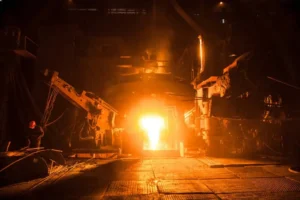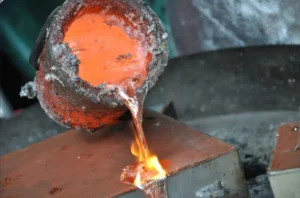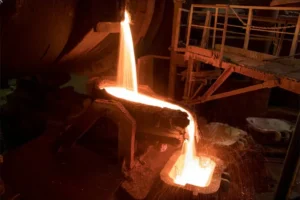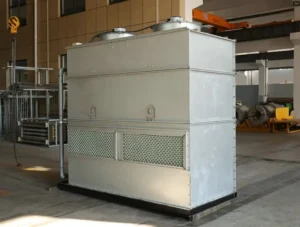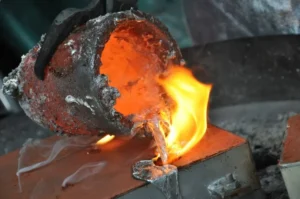Là cốt lõi của hệ thống sưởi công nghiệp hiện đại, sự phát triển của công nghệ cung cấp năng lượng sưởi ấm cảm ứng phản ánh sâu sắc sự tiến bộ của điện tử công suất. Từ thyristor đời đầu (Scr) cung cấp năng lượng cho Transistor lưỡng cực có cổng cách điện phổ biến hiện nay (IGBT) nguồn điện, cấu trúc liên kết mạch cũng đã phát triển từ cộng hưởng nối tiếp sang cộng hưởng song song. Bài viết đánh giá sự phát triển của công nghệ cung cấp điện IGBT, so sánh ưu điểm và nhược điểm của các cấu trúc liên kết mạch khác nhau, và hướng tới triển vọng ứng dụng của Silicon Carbide thế hệ tiếp theo (SiC) thiết bị điện.
Sự trỗi dậy của công nghệ IGBT: Một cuộc cách mạng về nguồn cung cấp năng lượng sưởi ấm cảm ứng
Trước sự trưởng thành của công nghệ IGBT, nguồn cung cấp năng lượng sưởi ấm cảm ứng chủ yếu sử dụng nguồn điện tần số trung bình dựa trên thyristor. Trong khi công nghệ này đã trưởng thành và chi phí thấp, nó phải chịu tần số hoạt động thấp, hiệu suất kém hiệu quả, và ô nhiễm sóng hài đáng kể cho lưới điện.
Vào cuối những năm 1980 và đầu những năm 1990, IGBT—một thiết bị điện được điều khiển hoàn toàn kết hợp trở kháng đầu vào cao của MOSFET và độ sụt điện áp ở trạng thái thấp của GTR—bắt đầu xuất hiện trong trường gia nhiệt cảm ứng. Sự ra đời của IGBT đã mang lại những thay đổi mang tính cách mạng đối với nguồn cung cấp năng lượng sưởi ấm cảm ứng:
- Tần số chuyển mạch cao hơn: Tốc độ chuyển mạch của IGBT vượt trội hơn nhiều so với thyristor, cho phép tần số hoạt động của nguồn điện tăng từ vài kilohertz lên hàng chục hoặc thậm chí hàng trăm kilohertz. Điều này cho phép phạm vi ứng dụng sưởi ấm rộng hơn, chẳng hạn như làm cứng bề mặt và gia nhiệt xuyên qua các thanh có đường kính nhỏ.
- Hiệu quả cao hơn: Tổn thất truyền tải và chuyển mạch tương đối thấp của IGBT đã cải thiện đáng kể hiệu suất tổng thể của nguồn điện, giảm tiêu thụ năng lượng.
- Hiệu suất kiểm soát vượt trội: Là thiết bị được điều khiển hoàn toàn, IGBT có thể đạt được sự điều chỉnh công suất đầu ra chính xác và nhanh chóng thông qua các kỹ thuật như Điều chế độ rộng xung (xung điện), nâng cao độ chính xác điều khiển và tính linh hoạt của quá trình gia nhiệt.
- Kích thước và trọng lượng nhỏ hơn: Việc tăng tần số hoạt động cho phép giảm đáng kể kích thước và trọng lượng của các bộ phận thụ động như máy biến áp, cuộn cảm, và tụ điện, làm cho thiết bị nhỏ gọn hơn.
Từ nối tiếp đến song song: Sự phát triển của cấu trúc liên kết mạch
Để đạt được sự truyền năng lượng hiệu quả trong nguồn cung cấp năng lượng sưởi ấm cảm ứng, Công nghệ cộng hưởng thường được sử dụng. Trong số đó, cộng hưởng nối tiếp và cộng hưởng song song là hai cấu trúc liên kết mạch chính.
Dòng chính sớm: Cộng hưởng loạt
Các nguồn cung cấp năng lượng sưởi ấm cảm ứng IGBT thời kỳ đầu thường áp dụng cấu trúc liên kết cộng hưởng nối tiếp. Đặc điểm chính của nó là cuộn cảm ứng và tụ bù mắc nối tiếp tạo thành mạch cộng hưởng nối tiếp..
Thuận lợi
- Đơn giản Khởi động: Mạch cộng hưởng nối tiếp khởi động tương đối dễ dàng, làm cho nó phù hợp cho các ứng dụng yêu cầu khởi động và dừng thường xuyên.
- Căng thẳng điện áp thấp trên thiết bị: Ở trạng thái cộng hưởng, tải xuất hiện hoàn toàn là điện trở, và điện áp đầu ra của biến tần phù hợp với điện áp tải, đặt yêu cầu điện áp thấp hơn trên IGBT.
- Đặc điểm dòng điện không đổi tự nhiên: Khi tần số hoạt động lệch khỏi điểm cộng hưởng, trở kháng mạch tăng nhanh, mang lại hiệu quả hạn chế dòng điện giúp bảo vệ các thiết bị điện khi có tải ngắn mạch.
Nhược điểm
- Việc kết hợp tải khó khăn: Điện trở tương đương của tải cộng hưởng nối tiếp rất thấp, yêu cầu một máy biến áp phù hợp để phù hợp với trở kháng giữa biến tần và tải. Điều này làm tăng thêm sự phức tạp, trị giá, và tổn thất cho hệ thống.
- Ứng dụng tần số cao hạn chế: Trong các ứng dụng tần số cao, điện cảm rò rỉ và điện dung phân bố của máy biến áp phù hợp ảnh hưởng nghiêm trọng đến hiệu suất của nó.
- Những thách thức bảo vệ quá dòng: Mặc dù có đặc tính hạn chế dòng điện tự nhiên, nếu xảy ra đoản mạch gần điểm cộng hưởng, dòng điện có thể tăng mạnh, đặt ra mối đe dọa đáng kể cho IGBT và gây khó khăn cho việc bảo vệ.
Dòng chính hiện đại: Cộng hưởng song song
Với những tiến bộ công nghệ, Cấu trúc liên kết cộng hưởng song song đã dần trở thành lựa chọn chủ đạo cho các nguồn cung cấp năng lượng cho lò cảm ứng công suất vừa và lớn. Đặc điểm của nó là cuộn dây cảm ứng và tụ bù được mắc song song, hình thành mạch cộng hưởng song song.
Thuận lợi
- Khả năng thích ứng tải mạnh: Trở kháng tương đương của tải cộng hưởng song song cao, cho phép nó được kết nối trực tiếp với các đầu ra của biến tần mà không cần máy biến áp phù hợp. Điều này đơn giản hóa cấu trúc mạch, nâng cao hiệu quả và độ tin cậy.
- Phạm vi điều chỉnh công suất rộng: Có thể dễ dàng đạt được phạm vi điều chỉnh công suất rộng bằng cách điều chỉnh điện áp hoặc tần số đầu ra của biến tần.
- Bảo vệ quá áp tự nhiên: Điện áp trên mạch cộng hưởng song song cao nhất khi cộng hưởng. Khi tải thay đổi hoặc trở thành mạch hở, điện áp giảm, cung cấp mức độ bảo vệ cho các thiết bị như IGBT.
- Thích hợp cho các ứng dụng công suất cao: Việc không có máy biến áp đầu ra khiến nó đặc biệt thuận lợi trong các ứng dụng công suất cao, dẫn đến một cấu trúc nhỏ gọn hơn và chi phí thấp hơn.
Nhược điểm
- Tương đối phức tạp Khởi động: Cộng hưởng song song yêu cầu một chiến lược điều khiển và mạch khởi động cụ thể.
- Căng thẳng hiện tại cao trên các thành phần: Tại sự cộng hưởng, dòng điện chạy qua cuộn dây cảm ứng và tụ điện lớn hơn nhiều so với dòng điện ra bởi biến tần. Điều này đặt ra yêu cầu cao về khả năng mang dòng của tụ bù.
Động lực của sự tiến hóa: Khi nhu cầu về công suất cao hơn, hiệu quả, và độ tin cậy trong lò cảm ứng tăng lên, cấu trúc liên kết cộng hưởng song song, với ưu điểm là loại bỏ máy biến áp phù hợp, cấu trúc đơn giản, và dễ dàng đạt được công suất cao, dần dần thay thế cộng hưởng nối tiếp để trở thành giải pháp ưu tiên cho tần số trung bình đến cao, nguồn cung cấp năng lượng cho lò cảm ứng công suất cao.
Nhìn về tương lai: Triển vọng ứng dụng của Silicon Carbide (SiC) Thiết bị điện
Mặc dù công nghệ IGBT đã rất trưởng thành, hiệu suất của nó đang tiến gần đến giới hạn vật lý của vật liệu silicon. Để nâng cao hơn nữa hiệu suất của nguồn cung cấp năng lượng sưởi ấm cảm ứng, ngành công nghiệp đã chuyển sự chú ý sang vật liệu bán dẫn dải rộng thế hệ thứ ba, đại diện bởi Silicon Carbide (SiC).
So với IGBT dựa trên silicon truyền thống, MOSFET SiC mang lại những ưu điểm đáng kể sau.
| Tính năng | Silicon (Và) IGBT | Cacbua silic (SiC) MOSFET | Ý nghĩa đối với nguồn cung cấp năng lượng cho lò cảm ứng |
| Chuyển đổi tốc độ | Chậm hơn | Cực nhanh (Nhanh hơn nhiều lần so với IGBT) | Tần số cao hơn: Cho phép đẩy tần số hoạt động lên phạm vi hàng trăm kHz hoặc thậm chí MHz, cho phép sưởi ấm tốt hơn và hiệu quả hơn. |
| Mất chuyển đổi | Cao hơn | Cực thấp (Có thể giảm bằng >80%) | Hiệu quả cao hơn: Giảm đáng kể tổn thất bên trong của nguồn điện, tiết kiệm năng lượng và giảm chi phí vận hành. |
| Kháng cự | Thấp | Cực thấp | Giảm tổn thất dẫn truyền: Cải thiện hơn nữa hiệu quả cung cấp điện, đặc biệt là trong quá trình hoạt động hiện tại cao. |
| Nhiệt độ hoạt động | Thấp hơn (Nhiệt độ ngã ba. tiêu biểu <175°C) | Cao hơn (Nhiệt độ ngã ba. có thể vượt quá 200°C) | Hệ thống làm mát đơn giản hóa: Giảm nhu cầu về hệ thống làm mát, làm cho nguồn điện nhỏ gọn và đáng tin cậy hơn. |
| Khả năng điện áp cao | Tốt | Xuất sắc | Mạch đơn giản hóa: Điện áp đánh thủng cao của thiết bị SiC tạo điều kiện thuận lợi cho việc thiết kế nguồn điện đầu vào điện áp cao. |
Sự chuyển đổi do công nghệ SiC mang lại
- Cải thiện hiệu suất tối đa: Các nguồn cung cấp năng lượng sưởi ấm cảm ứng sử dụng thiết bị SiC dự kiến sẽ có sự cải thiện hiệu suất từ mức ~95% hiện tại với IGBT trở lên. 98%. Trong khi đó, sự gia tăng đáng kể về tần số hoạt động sẽ mở ra những ứng dụng mới cho hệ thống sưởi cảm ứng tần số cực cao (ví dụ., tăng trưởng vật liệu bán dẫn, hàn thiết bị y tế chính xác).
- Thu nhỏ hệ thống và trọng lượng nhẹ hơn: Do tần số chuyển mạch cao hơn và tổn thất thấp hơn, kích thước của các thành phần từ tính (cuộn cảm, máy biến áp) và tản nhiệt có thể giảm đáng kể, đạt được mật độ năng lượng cao hơn.
- Độ tin cậy cao hơn: Khả năng chịu nhiệt độ cao tuyệt vời và độ tăng nhiệt độ hoạt động thấp hơn của thiết bị SiC giúp kéo dài tuổi thọ sử dụng và độ tin cậy của hệ thống cao hơn.
Những thách thức và triển vọng
Hiện nay, thách thức chính đối với các thiết bị SiC là giá thành tương đối cao và độ phức tạp trong thiết kế mạch điều khiển của chúng.. Tuy nhiên, khi quy trình sản xuất hoàn thiện và quy mô thị trường mở rộng, giá thành của thiết bị SiC đang giảm nhanh chóng. Có thể dự đoán rằng trong thời gian sắp tới, khi vấn đề chi phí được giải quyết, các thiết bị bán dẫn băng thông rộng do SiC đại diện sẽ dần thay thế IGBT để trở thành cốt lõi của thế hệ hiệu suất cao tiếp theo, tần số cao, nguồn cung cấp năng lượng cho lò cảm ứng mật độ cao, công nghệ sưởi ấm cảm ứng hàng đầu lên một tầm cao mới.
Phần kết luận
Từ nối tiếp đến song song, từ thyristor đến IGBT, sự phát triển của công nghệ cung cấp điện lò cảm ứng luôn theo đuổi hiệu quả cao hơn, độ tin cậy mạnh hơn, và hiệu suất kiểm soát tốt hơn. Mỗi lần lặp lại công nghệ đã mang lại những thay đổi sâu sắc cho lĩnh vực sưởi ấm công nghiệp. Hôm nay, chúng ta đang đứng trước ngưỡng cửa của một cuộc cách mạng công nghệ mới. Thế hệ tiếp theo của thiết bị điện, tập trung vào Silicon Carbide (SiC), sẽ định hình lại tương lai của nguồn cung cấp năng lượng sưởi ấm cảm ứng với những lợi thế về hiệu suất vô song của chúng, truyền động lực mới mạnh mẽ vào việc bảo tồn năng lượng, giảm phát thải, và sự chuyển đổi của ngành sản xuất.


